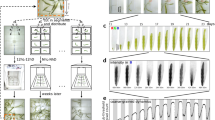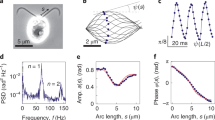Abstract
Halobacteria spontaneously reverse their swimming direction about every 10 s. This periodicity can be altered by light stimuli. We found that temporal exponential changes in light intensity, depending on wavelength and sign, lengthened or shortened the intervals between reversals. Within a limited range of steepness, light gradients enforced a new stable periodicity upon the system. Outside this range, they caused period doubling or induced a sequence of reversal events without any obvious regularity. An analysis of a functional relationship between apparently irregular periods by plotting each period as a function on the preceding one yielded a clearly discernible non-random structure, which shows some similarities to the one obtained by a model calculation for a periodically perturbed limit cycle oscillator. These results indicate that external forcing of the system may generate chaos. When the decay of intracellular sensory signals is delayed by inhibition of protein methylation the transition from periodic to aperiodic behavior occurs at a lower steepness of the gradient. We therefore assume that the generation of either periodic or deterministic chaotic behavior is determined by the relation between the signal lifetime and the frequency of stimulus inputs. The strong indications for transitions from periodic to chaotic behavior can be regarded as a further support of our hypothesis that the behavioral pattern of Halobacterium is controlled by an endogeneous oscillator.
Similar content being viewed by others
References
Alam M, Oesterhelt D (1984) Morphology, function and isolation of halobacterial flagella. J Mol Biol 176:459–475
Block SM, Segall JE, Berg HC (1983) Adaptation kinetics in bacterial chemotaxis. J Bacteriol 154:312–323
Decroly O, Goldbeter A (1982) Birhythmicity, chaos and other patterns of temporal self-organization in a multiply regulated biochemical system. Proc Natl Acad Sci USA 79: 6917–6921
Hildebrand E, Dencher N (1975) Two photosystems controlling behavioural responses of Halobacterium halobium. Nature 257:46–48
Hildebrand E, Schimz A (1983) Photosensory behavior of a bacteriorhodopsin-deficient mutant, ET-15, of Halobacterium halobium. Photochem Photobiol 37:581–584
Hildebrand E, Schimz A (1986) Integration of photosensory signals in Halobacterium halobium. J Bacteriol 167:305–311
Hildebrand E, Schimz A (1987) Role of the response oscillator in inverse responses of Halobacterium halobium to weak light stimuli. J Bacteriol 169:254–259
Markus M, Hess B (1984) Transition between oscillatory modes in a glycolytic model system. Proc Natl Acad Sci USA 81: 4394–4398
Marwan W, Oesterhelt D (1987) Signal formation in the halobacterial photophobic response mediated by a fourth retinal protein (P480). J Mol Biol 195:333–342
McCain DA, Amici LA, Spudich JL (1987) Kinetically resolved states of the Halobacterium halobium flagellar motor switch and modulation of the switch by sensory rhodopsin I. J Bacteriol 169:4750–4758
Olsen LF (1984) The enzyme and the strange attractor-comparisons of experimental and numerical data for an enzyme reaction with chaotic motion. In: Schuster P (ed) Stochastic phenomena and chaotic behavior in complex systems. Springer, Berlin Heidelberg New York, pp 110–123
Olsen LF, Degn H (1985) Chaos in biological systems. Q Rev Biophys 18:165–225
Rössler OE (1976a) An equation for continuous chaos. Phys Lett 57A:397–398
Rössler OE (1976b) Chaotic behaviour in simple reaction systems. Z Naturforsch 31a:259–264
Schaffer WM, Ellner S, Kot M (1986) Effects of noise on some dynamical models in ecology. J Math Biol 24:479–523
Schimz A, Hildebrand E (1985) Response regulation and sensory control in Halobacterium halobium based on an oscillator. Nature 317:641–643
Schimz A, hildebrand E (1986) Entrainment and temperature dependence of the response oscillator in Halobacterium halobium. J Bacteriol 166:689–692
Schimz A, Hildebrand E (1987) Effects of cGMP, calcium and reversible methylation on sensory signal processing in halobacteria. Biochim Biophys Acta 923:222–232
Shaw R (1984) The dripping faucet as a model chaotic system. The Science Frontier Express Series, Aerial Press, Santa Cruz
Spudich JL, Stoeckenius W (1979) Photosensory and chemosensory behavior of Halobacterium halobium. Photobiochem Photobiophys 1:43–53
Takahashi T, Tomioka H, Kamo N, Kobatake Y (1985) A photosystem other than PS 370 also mediates the negative phototaxis of Halobacterium halobium. FEBS Microbiol Lett 28:161–164
Tomita K (1982) Chaotic responses of non-linear oscillators. Phys Rep 86:113–167
Wolff EK, Bogomolni RA, Scherrer P, Hess B, Stoeckenius W (1986) Color discrimination in halobacteria: Spectroscopic characterization of a second sensory receptor covering the blue-green region of the spectrum. Proc Natl Acad Sci USA 83:7272–7276
Author information
Authors and Affiliations
Rights and permissions
About this article
Cite this article
Schimz, A., Hildebrand, E. Periodicity and chaos in the response of Halobacterium to temporal light gradients. Eur Biophys J 17, 237–243 (1989). https://doi.org/10.1007/BF00254281
Received:
Accepted:
Issue Date:
DOI: https://doi.org/10.1007/BF00254281




